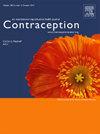在训练有素的临床医生中提供程序性流产护理的障碍:对流产培训计划的评估。
IF 2.3
2区 医学
Q1 OBSTETRICS & GYNECOLOGY
引用次数: 0
摘要
目的:了解临床医生在参加流产培训项目后提供程序性流产护理时面临的障碍和促进因素,以及这些障碍如何根据专业特征(如专业、职业阶段)和制度因素(如诊所政策)而有所不同。研究设计:本分析是临床培训计划的一部分,该计划侧重于使临床医生具备手术流产技能。数据收集时间为2020年7月7日至2024年1月1日,包括半结构化访谈和项目完成后每年收集的项目后调查。完成至少两项调查的项目参与者包括在内。结果:44名妇产科和家庭医学医生符合本研究的纳入标准。大约三分之一的项目参与者在培训后6个月和最后一次调查时(培训后18、30或42个月)提供了手术流产护理,三分之一的参与者在两个时间点都没有提供。随着项目参与者在实践中变得更加成熟(尤其是住院医师后),提供堕胎护理的障碍和促进者往往会发生变化。虽然地方和州政策影响到提供护理的能力,但据报道,其他体制和专业因素,包括职业阶段,往往因专业和职业阶段而有所不同。结论:结构性和制度性障碍对那些寻求提供培训后护理的人来说是重要的。希望支持堕胎护理的机构也应确保向家庭医学医生提供这种支持。由于项目参与者在找工作方面经常遇到困难,培训项目应侧重于帮助项目参与者建立供应商网络,以提供全面的培训和就业支持。启示:制度、职业和个人因素对个体利用堕胎培训的能力有复合影响。虽然流产培训项目对培训提供者很有帮助,但这些项目的参与者需要额外的网络和机构支持,才能提供程序性流产护理。本文章由计算机程序翻译,如有差异,请以英文原文为准。
Barriers to providing procedural abortion care among trained clinicians: An evaluation of an abortion training program
Objectives
Understand the barriers and facilitators that clinicians face in delivering procedural abortion care following participation in an abortion training program and how these barriers may differ based on professional characteristics (e.g. specialty, career stage) and institutional factors (e.g., clinic policies).
Study design
This analysis is part of a larger evaluation of a clinical training program focused on equipping clinicians with procedural abortion skills. Data collection occurred 07/2020−01/2024 and included semi-structured interviews and post-program surveys collected annually following program completion. Program participants who completed at least two surveys are included.
Results
Forty-four ob-gyn and family medicine physicians met the inclusion criteria for this study. About one-third of program participants provided procedural abortion care 6 months following training and at their last survey (18-, 30- or 42 months post-training), and one-third did not provide at either time point. Barriers and facilitators for those providing abortion care often changed as program participants became more established in their practices (particularly post-residency). While local and state policies influenced the ability to provide care, other institutional and professional factors, including career stage, were often reported with some differences by specialty and career stage.
Conclusions
Structural and institutional barriers proved significant to those seeking to provide care post-training. Institutions looking to support abortion care should also ensure that this support is given to family medicine physicians. As program participants often had challenges finding work, training programs should focus on helping program participants build networks of providers to provide comprehensive training and job placement support.
Implications
Institutional, career and personal factors have compounding effects on individuals’ ability to utilize their abortion training. While abortion training programs are helpful in training providers, program participants from these programs need additional networking and institutional supports to be able to provide procedural abortion care.
求助全文
通过发布文献求助,成功后即可免费获取论文全文。
去求助
来源期刊

Contraception
医学-妇产科学
CiteScore
4.70
自引率
17.20%
发文量
211
审稿时长
69 days
期刊介绍:
Contraception has an open access mirror journal Contraception: X, sharing the same aims and scope, editorial team, submission system and rigorous peer review.
The journal Contraception wishes to advance reproductive health through the rapid publication of the best and most interesting new scholarship regarding contraception and related fields such as abortion. The journal welcomes manuscripts from investigators working in the laboratory, clinical and social sciences, as well as public health and health professions education.
 求助内容:
求助内容: 应助结果提醒方式:
应助结果提醒方式:


